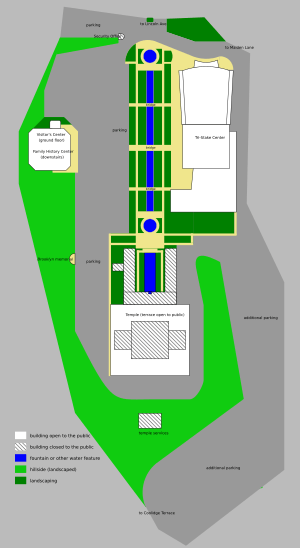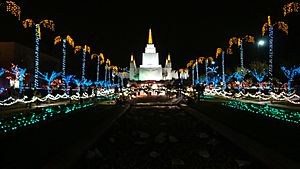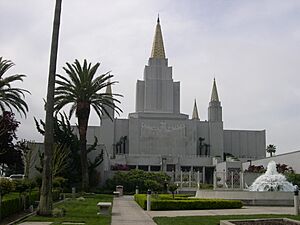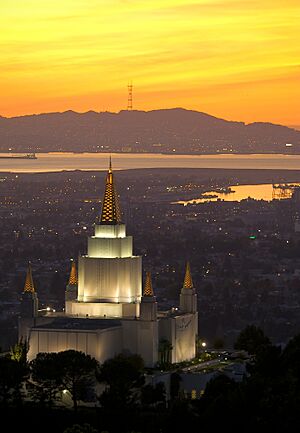Oakland California Temple facts for kids
| Oakland California Temple | ||||||||||||||||||||||||||||||||||||||||||||
|---|---|---|---|---|---|---|---|---|---|---|---|---|---|---|---|---|---|---|---|---|---|---|---|---|---|---|---|---|---|---|---|---|---|---|---|---|---|---|---|---|---|---|---|---|
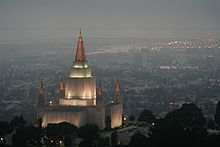 |
||||||||||||||||||||||||||||||||||||||||||||
| Number | 13 | |||||||||||||||||||||||||||||||||||||||||||
| Dedicated | Quick facts for kids November 17, 1964 byDavid O. McKay |
|||||||||||||||||||||||||||||||||||||||||||
| Site | 18.3 acres (7.4 hectares) | |||||||||||||||||||||||||||||||||||||||||||
| Floor area | 95,000 sq ft (8,800 m2) | |||||||||||||||||||||||||||||||||||||||||||
| Height | 170 ft (52 m) | |||||||||||||||||||||||||||||||||||||||||||
| Preceded by | London England Temple | |||||||||||||||||||||||||||||||||||||||||||
| Followed by | Ogden Utah Temple | |||||||||||||||||||||||||||||||||||||||||||
| Official website: https://www.churchofjesuschrist.org/temples/details/oakland-california-temple • News & images | ||||||||||||||||||||||||||||||||||||||||||||
|
||||||||||||||||||||||||||||||||||||||||||||
The Oakland California Temple is a special building for The Church of Jesus Christ of Latter-day Saints. It was the 15th temple built and the 13th one still in use. Plans for the temple were announced in 1961 by David O. McKay. Construction began in 1962, and the temple was officially opened in 1964. It sits high up in the Oakland hills and is a well-known landmark.
Contents
Exploring Temple Hill
The temple is part of a larger area called "Temple Hill." This area has several buildings and beautiful gardens. The oldest building on site is the Interstake Center, built in the 1950s. It has chapels for church services, an auditorium, a gym, classrooms, and offices.
The auditorium is quite large, seating 1,600 people. Many groups from Brigham Young University have performed there. It can even be made bigger to fit two basketball courts! The NBA's Golden State Warriors used to practice there. Today, it's home to the Temple Hill Symphony Orchestra, Choir, and Dance Company.
There's also a Family History Center where people can learn about their ancestors. A visitors' center, an employment center, and a distribution center are also on the grounds. You can also find the headquarters for the California Oakland–San Francisco Mission here. A small memorial for the Brooklyn ship is also on the property.
From the temple grounds and terrace, you can see amazing views of the Bay Area, including downtown Oakland, the Bay Bridge, Yerba Buena Island, San Francisco, and the Golden Gate Bridge.
Visitors' Center: Learn and Explore
Adjacent to the temple is the visitors' center, which opened in 1992. It has interesting artwork and displays. You can see a copy of the famous Christus statue by Bertel Thorvaldsen. Volunteers are there to answer questions about the temple and the Church. The center was updated in 2004 to focus more on Jesus Christ. It is open to everyone.
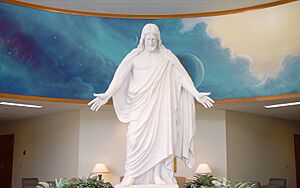
Beautiful Gardens and Reflection Pool
The temple grounds cover about 18 acres. They feature a long waterfall, a peaceful reflection pool, fountains, and a roof-terrace garden. Many local photographers love to take pictures here. The gardens are filled with colorful flowers, palm trees, and a man-made river.
Christmas Lights: A Holiday Tradition
Every holiday season since 1978, the temple grounds light up with thousands of Christmas lights. It started with 50,000 lights and grew to 500,000 by 1998. These lights can be seen from the San Francisco Bay! Along with the lights, there are musical performances and dances to celebrate Christmas.
Family History Center: Discover Your Roots
The family history center helps people find and learn about their ancestors. It's open to everyone, not just members of the Church. Volunteers are ready to help anyone interested in tracing their family tree. Many people from the local community visit the center. In fact, most visitors are not members of the Church.
Temple Design and Inside Look
The temple was designed by Harold W. Burton in 1962. It combines different styles like Art Deco, Asian, and mid-century modern. Later renovations in 2019 were led by David Hunter and Karen Willardson. The building has many Asian-inspired details in its structure and interior. Like other temples, it was built using the "finest craftsmanship and materials available."
The temple is built on an 18.3-acre plot. It has special rooms for ceremonies and a total floor area of 95,000 square feet. The temple and its surrounding buildings are sometimes called "Temple Hill."
Outside the Temple
The Oakland California Temple is unique because it's the only one with a modern five-spire design. The five golden spires shine in the sun, with the tallest reaching 170 feet high. The outside of the temple is made of reinforced concrete covered with white granite.
On the north and south sides of the temple, there are two decorative sculptures called friezes. The south side shows Jesus Christ coming down from heaven to the people in the Americas after His resurrection. The north side shows Christ teaching His disciples, including both men and women. In the front garden, there's a statue of children with a bronze plaque. It has a scripture from the Book of Mormon about Christ blessing the children during His visit to ancient America. Near the main entrance, it says, "Holiness to the Lord, the House of the Lord."
Exterior Lighting: A Beacon at Night
At night, the temple is beautifully lit up. Some people call it "the beacon on the hill" because it can be seen from much of the Bay Area. The FAA (Federal Aviation Administration) even uses the temple as a navigation beacon for planes.
Inside the Temple
The inside of the temple is designed to help visitors remember Jesus Christ. The decor is calming, with shades of tan and brown. You'll find paintings and artwork throughout the temple. The walls have white oak paneling, and the floors are marble.
The lobby has relief artwork showing Adam and Eve and another showing Christ in the Garden of Gethsemane. Other paintings show scenes from Jesus Christ's life and beautiful California landscapes. Some rooms have full-length mirrors, elegant crystal lights, and comfortable seating with oriental designs. The baptistry has gold leaf decorations on the ceiling, marble columns, and bronze railings. The sealing rooms have dark cherry wood paneling and backlit marble altars. Mirrors in these rooms create an amazing endless reflection. Some sealing rooms also have curved ceilings.
Temple History and Renovation
Plans for temples in California, including the Oakland Temple, date back to 1847. Early Latter-day Saints were told that "the shores of the Pacific may yet be overlooked from the Temple of the Lord."
The land for the Oakland Temple was bought in 1943. Construction began in 1962.
In 2017, the Church announced that the temple would close for renovations in 2018. The renovations were completed in 2019. After the work was done, there was a public open house from May 11 to June 1, 2019. The temple was rededicated on June 16, 2019, by Dallin H. Oaks. The renovation included updating the electrical system, installing new carpet, and restoring the outdoor reflection pool. A new waiting area was added with windows that let in light from the pool outside.
In 2020, the temple temporarily closed due to the coronavirus pandemic.
And it Came to Pass Pageant
For many years, local members performed a special musical play called the "Temple Pageant" in the nearby Interstake Center. This play, also known as And it Came to Pass, told the history of the Church. It was one of only a few such pageants in the country. It was unique because it was performed indoors and had a live orchestra. The pageant was eventually shortened to an hour and a half. In 2007, it was announced that the pageant would no longer be held.
Organizations at Temple Hill
Several groups are based at Temple Hill:
- The Temple Hill Symphony Orchestra was formed in 1985. It has 52 members, and about a third of them are not members of the Church. It offers free concerts to the public.
- The Temple Hill Public Affairs Council works to share information about the Church and its mission.
- The Temple Hill Choir and the Behold Dance Collective—The Temple Hill Dance Company are also based here.
Images for kids
See also
 In Spanish: Templo de Oakland para niños
In Spanish: Templo de Oakland para niños


